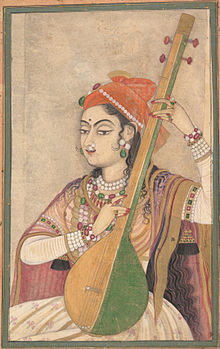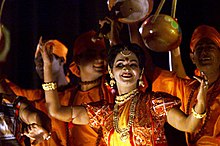Hindustani Classical music
| Music of India | |
|---|---|

A Lady Playing the Tanpura, ca. 1735 (Rajasthan)
|
|
| Genres | |
|
|
| Media and performance | |
| Music awards | |
| Music festivals | |
| Music media | |
| Nationalistic and patriotic songs | |
| National anthem | Jana Gana Mana |
| Regional music | |
|
|
| Music of Pakistan | |
|---|---|
 |
|
| Genres | |
| Specific forms | |
| Religious music | |
| Traditional music | |
| Media and performance | |
| Music awards |
Lux Style Awards Hum Awards Pakistan Media Awards |
| Music festivals |
All Pakistan Music Conference Lahore Music Meet |
| Music media | |
| Nationalistic and patriotic songs | |
| National anthem | Qaumi Taranah |
| Regional music | |
| Local forms | |
| Related areas | |
| Music of Bangladesh | |
|---|---|

|
|
| Genres | |
| Specific forms | |
| Religious music | |
| Ethnic music | |
| Traditional music | |
| Media and performance | |
| Music awards | |
| Music festivals | |
| Music media |
Radio Television Internet |
| Nationalistic and patriotic songs | |
| National anthem | Amar Sonar Bangla |
| Other |
Notuner Gaan (National March) Ekusher Gaan (Ode to the Language Movement) |
| Regional music | |
| Related areas | |
| Other regions | |
Radio
Television
Internet
Hindustani classical music ([hin̪d̪us̪t̪ɑːn̪i]) is the Hindustani or North Indian style of Indian classical music. The style is sometimes called North Indian classical music or Shāstriya Sangīt. It is a tradition that has been evolving since the 12th century CE, in North India. Today, it is one of the two subgenres of Indian classical music, the other being Carnatic music, the classical tradition of South India.
The traditional popular music genre of Indonesia, Dangdut, and its classical version is partly derived from Hindustani classical music, especially in the basis of instrumentation, melody, harmony, and beat. Its main instruments are Tabla and sometimes Sitar and modern guitars.
It is a tradition for performers who have reached a distinguished level of achievement to be awarded titles of respect; Hindus are usually referred to as pandit and Muslims as ustad. An aspect of Hindustani music going back to Sufi times is the tradition of religious neutrality: Muslim ustads may sing compositions in praise of Hindu deities, and vice versa.
Around the 12th century, Hindustani classical music diverged from what eventually came to be identified as Carnatic classical music. The central notion in both these systems is that of a melodic mode or raga, sung to a rhythmic cycle or tala. These principles were refined in the musical treatises Natya Shastra, by Bharata (2nd–3rd century CE), and Dattilam (probably 3rd–4th century CE).
...
Wikipedia
